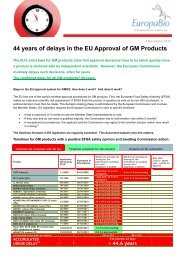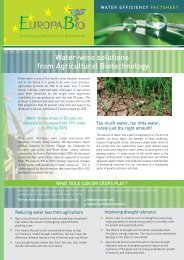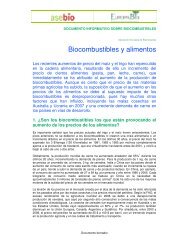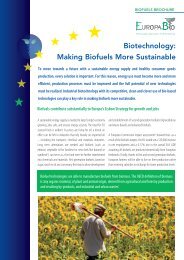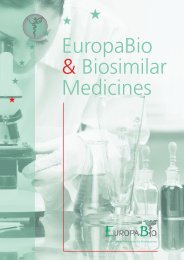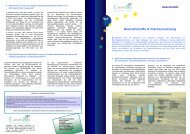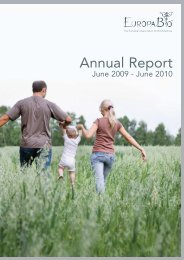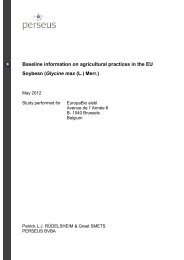GM crops: Reaping the benefits, but not in Europe - Europabio
GM crops: Reaping the benefits, but not in Europe - Europabio
GM crops: Reaping the benefits, but not in Europe - Europabio
Create successful ePaper yourself
Turn your PDF publications into a flip-book with our unique Google optimized e-Paper software.
12<br />
6. LOST ECONOMIC OPPORTUNITIES IN THE EU<br />
A (<strong>Europe</strong>an) technology denied to most <strong>Europe</strong>ans<br />
In <strong>the</strong> second half of <strong>the</strong> 1980s, Van Montagu and Schell were <strong>the</strong> first to develop and test genetically<br />
eng<strong>in</strong>eered plants at <strong>the</strong> University of Ghent <strong>in</strong> Belgium. In 2010, cultivation <strong>in</strong> <strong>the</strong> EU was limited to<br />
two approved events, cultivated on 91,643 hectares <strong>in</strong> eight Member States. A large number of <strong>GM</strong><br />
<strong>crops</strong> have been wait<strong>in</strong>g for years for EU approval. Worse still for <strong>Europe</strong>an farmers, <strong>GM</strong> cultivation of<br />
certa<strong>in</strong> <strong>crops</strong> has been banned, though <strong>the</strong> bans are legally questionable, <strong>in</strong> Austria, Bulgaria, France,<br />
Germany, Greece, Hungary and Luxembourg.<br />
A widen<strong>in</strong>g competitive disadvantage<br />
Cont<strong>in</strong>ued non-availability of <strong>the</strong> technology for EU farmers essentially leads to a competitive<br />
disadvantage compared to global competitors on world markets. As new seeds cont<strong>in</strong>ue to come<br />
to market <strong>in</strong> o<strong>the</strong>r countries, <strong>but</strong> <strong>not</strong> <strong>the</strong> EU, this gap will widen.<br />
Quantify<strong>in</strong>g <strong>Europe</strong>’s foregone <strong>benefits</strong><br />
<strong>Europe</strong>an farmer marg<strong>in</strong>s would <strong>in</strong>crease by an estimated ¤443 to ¤929 million each year, were <strong>the</strong>y<br />
allowed to grow <strong>GM</strong> maize, cotton, soya bean, rapeseed and sugar beet, where <strong>the</strong>re is agronomic<br />
need 34 . Maize, rapeseed and sugar beet have <strong>the</strong> highest potential. <strong>Europe</strong> is likely to lose out even<br />
more as new <strong>GM</strong> varieties are rapidly be<strong>in</strong>g planted by farmers <strong>in</strong> o<strong>the</strong>r parts of <strong>the</strong> world.



